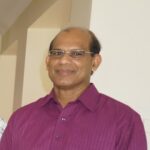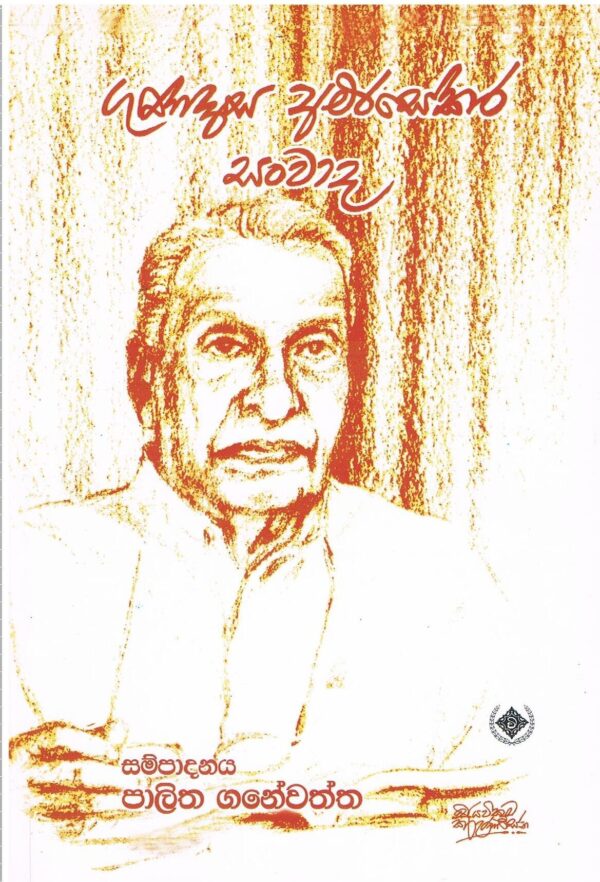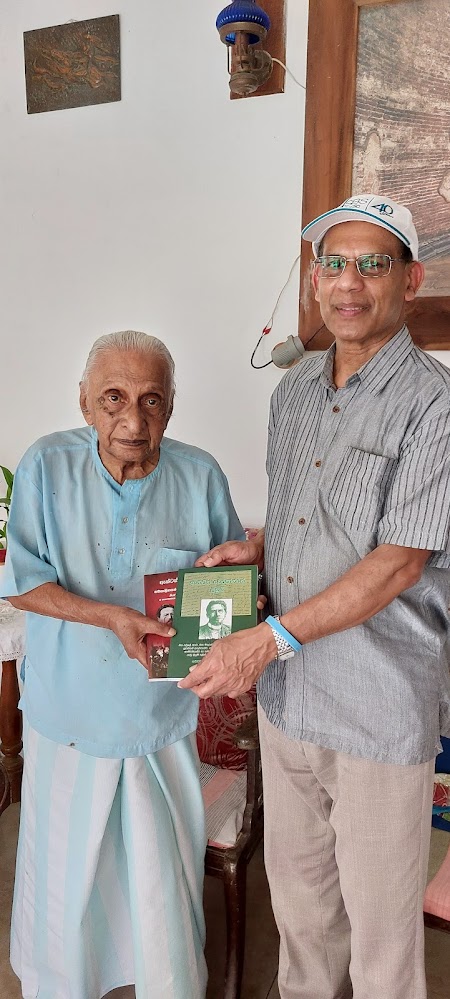Dr Gunadasa Amarasekara celebrates 95th birthday in November 2024 – By Dr Palitha Ganewatta
 Dr Gunadasa Amarasekera, is no doubt the foremost Maha Gathkaru of Sri Lanka in this 21st Century. He has contributed enormously and creatively to the Sinhala literary fields of novels, short stories, poetry, and literary criticism during the last six decades. His vivid contribution to the modern political affairs of the country under the name of Jathiyaka Chinthanaya on the verge of 21st century is also noteworthy The most pleasing and encouraging phenomenon is, he a nonagenarian, continues to produce literary creations, as evident by the release of his latest novel, Maha Gedara. It is therefore appropriate, I believe, to shed some light on certain aspects of his literary contribution now, rather than waiting, despite the commonly accepted practice of evaluating the legacy of great writers posthumously.
Dr Gunadasa Amarasekera, is no doubt the foremost Maha Gathkaru of Sri Lanka in this 21st Century. He has contributed enormously and creatively to the Sinhala literary fields of novels, short stories, poetry, and literary criticism during the last six decades. His vivid contribution to the modern political affairs of the country under the name of Jathiyaka Chinthanaya on the verge of 21st century is also noteworthy The most pleasing and encouraging phenomenon is, he a nonagenarian, continues to produce literary creations, as evident by the release of his latest novel, Maha Gedara. It is therefore appropriate, I believe, to shed some light on certain aspects of his literary contribution now, rather than waiting, despite the commonly accepted practice of evaluating the legacy of great writers posthumously.
I first met Dr Amarasekera at his Nawala residence in 2001 when I presented to him my collection of short stories, Le Huru Suwanda, which he admired and repeatedly said afterwards that he had read the collection completely and will write a review for a newspaper. The following decades show a harmonious literary collaboration with this great writer, who participated in my three book launches held in Colombo. Those books were collections of short stories of the great Russian writer, Anton Chekhov, translated from the original Russian into Sinhalese.

I had the rare privilege of interviewing Dr. Amarasekara over the Special Broadcasting Services (SBS, Australia), where I was the executive producer of the Sinhalese Language radio program during the first decade of this century. The collection of those interviews was later published by Wijesuriya Grantha Kendraya under the title ‘Gunadasa Amarasekera Sanvaada’.
I thought it appropriate to share some thoughts, expressed by Dr Amarasekera, during those radio interviews, which I believe were not widely discussed amongst the contemporary literary circles in Sri Lanka.
It was interesting to note during the very first interview, Dr Amarasekera, referring to the well-known saying of Anton Chekhov that ‘medicine is his lawful wedded wife, and literature is his mistress’, said jokingly that literature is his lawful wife, and medicine is his mistress.
Although a dental surgeon by profession, Dr Amarasekera spent most of his time dedicating himself to producing literary creations. He was a contemporary of the greatest literary giants of the last century, Martin Wickremasinghe and Ediriweera Sarachchandra. Prof Sarachchandra was responsible for introducing Gunadasa Amarasekera to the literary field by selecting one of his early short stories for a collection of international short stories in the early 1950s. Despite the initial support and encouragement provided by Dr Sarachchandra, Dr Amarasekera had an antagonistic literary encounter with the Peradeniya literary circle led by Dr Sarachchandra in the early sixties of the last century. During one of my interviews, responding to a question regarding Peradeniya Literacy influence, Dr Amarasekera elaborated on the negative influence of the Peradeniya literary circle to our society. Dr Amarasekera pointed out his main reasons to get away from Peradeniya circle, in which he was an active contributor at the early stage of its existence. After publishing his two early novels – Yali Upannemi and Depa Noladdo, he had understood that those two were written under the influence of Peradeniya literary circle, which he believed was encouraged to produce imitative literary works under western influence, with no understanding of the deep-rooted Sinhala Buddhist culture of our society. He later denied those novels, not allowing their re-publication, realizing their negative impact to budding novelists, making them gain illusionary values alien to Sinhala Buddhist culture.

While discussing the above mentioned two literary giants, Dr Amarasekera revealed the contradictions of Ediriweera Sarachchandra’s literary legacy. He was of the opinion that Dr Sarachchandra, despite his comprehensive knowledge of the history of Sinhalese literature, was unable to produce a successful novel due to his inability to comprehend the social and cultural roots of Sinhala society, which I disputed in my response. Although, he highly regarded the contribution made by Martin Wickramasinghe to the Sinhala literary sphere, particularly to the development of the realistic novel, he believes that Piyadasa Sirisena, although his novels contain artistic shortcomings, was the first to introduce the realistic novel to Sinhala literary sphere.
One of the novel ideas expressed by Dr Amarasekara regarding Martin Wickramasinghe’s literary criticism is worth mentioning. Responding to one of the interview questions, he denied that Martin Wickramasinghe’s conclusion, elaborated in his critical work titled, ‘Japan Kama Katha Hevanella’, (The Sinhala Novel and the shadow of the Japanese erotic novel, published in 1969) that the Peradeniya literary circle produced novels imitating the post-second world war Japanese novel, was incorrect. While accepting Peradeniya literary circle as imitators, Dr Amarasekera believes the major inspiring factor for Peradeniya literary production was the blind imitation of the self-centered illusionary novels which appeared between the two world wars in Western Europe.
Talking about his short stories, he believes the ‘Ektamen Polovata’ published in 1972 was an attempt to get away from Peradeniya literary influence. This collection and the consecutively published collections of short stories, he believes, were not adequately comprehended by the Sri Lankan literary public. The reason for this, he describes, is the absence of sound literary criticism and the inability of the literary public to adapt to a wider society with its social cultural and historical aspects. Dr Amarasekera draws the same conclusion responding to the question of inadequate response received from the literary critics and the general reading public to his autobiographical ennealogy, beginning with ‘Gamanaka Mula’. This nine-volume series of novels, depict the life journey of the middle-class Sri Lankan society during the last century. Dr Amarasekara believes the trilogy of Martin Wickremasinghe, Gamperaliya, Kaliyugaya and Yuganthaya, only depicts the upper-class life journey of our society in the context of socio-political upheaval of the pre-independence Ceylon. Literature, he further mentions, should be an advanced conversation within any civilized society in the context of its social and cultural norms and the lack of this elevated conversation, he believes, is the major drawback to produce much required literary critics and literary criticism in our society.
Referring to his contribution to Sinhala poetry, Dr Amarasekara defined the Nisadas kavi (free verse) as a weed germinated in the Sinhala poetry field. He delineated that his first two collections of poetry, namely ‘Amal Biso’ and ‘Bhava Geetha’ were not free verse but had been composed using traditional meters.
Dr Amarasekera encapsulates at the conclusion of his ‘Sinhala Kavya Sangrahaya’, an exhaustive treatise of Sinhalese poetry, that western poetic patterns cannot and shouldn’t be employed to save Sinhalese poetry from its current pathetic state. During the interview he alluded to Sihala Folk poems, with which Sinhala Poetry evolved during its past deteriorating stages, as the only sensible and essential way to develop contemporary Sinhala Poetry. He considered Piya Samara, a poem by Cumarathunga Munidasa, which blends the folk and intellectual norms of Sinhala, to be the only vivid example illustrating the way to develop modern Sinhala poetry through folk poetry forms. He refers to Sinhala poetic language as the language of the heart (Hada Basa), which he believes should be evolved through Sinhala folk language.
Dr Amarasekara has enthusiastically responded during an interview dedicated to the modern Sinhalese novel. He emphasized that his critical work, Nosevuna Kedapatha (Unused Mirror) was an attempt to invite educated readers to save the modern Sinhala novel from its deteriorating state. He further stated the negative impact of the Peradeniya literary circle, which is still overshadowing the sensible development of the modern Sinhala novel. He believes a novel should depict the elevated social and cultural conversation (Uththara Sanvadaya) of the society, the lack of which, he believed, is the major contributing factor for the decline of the contemporary Sinhala novel.
This short essay is an attempt to present my thoughts on the unparalleled literary contribution made by Dr Gunadasa Amarasekera, who has inspired me with his thoughts expressed during interviews I conducted with him. I believe that this note will serve as a small tribute to this giant literary figure, who is a unique Sinhala cultural intellectual and a poet of distinction, who has contributed enormously to widen the social and cultural awareness of people of our motherland.
By Dr Palitha Ganewatta, Sydney
























